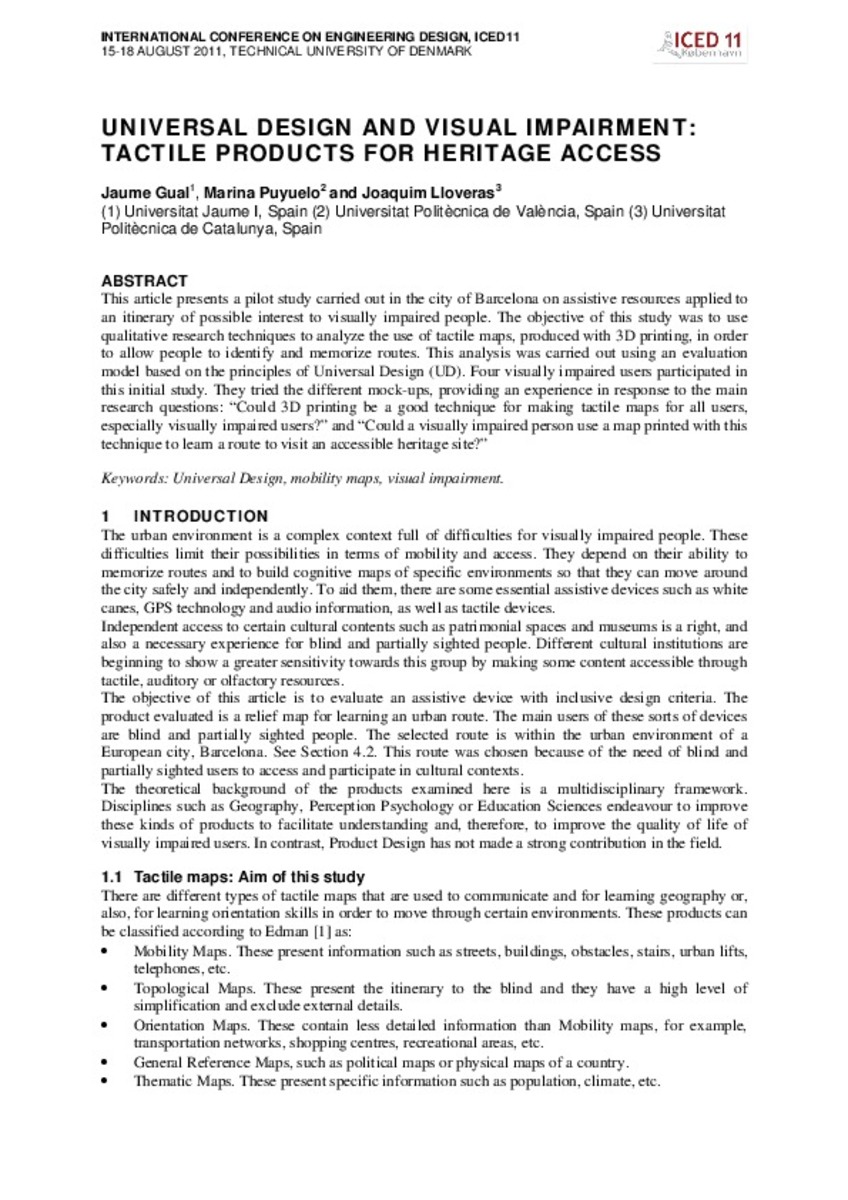Mostra el registre parcial de l'element
Universal design and visual impairment: tactile products for heritage access
| dc.contributor.author | Gual, Jaume | |
| dc.contributor.author | Puyuelo Cazorla, Marina | |
| dc.contributor.author | Lloveras, Joaquim | |
| dc.date.accessioned | 2019-02-25T18:55:15Z | |
| dc.date.available | 2019-02-25T18:55:15Z | |
| dc.date.issued | 2011 | |
| dc.identifier.citation | Gual, Jaume; Puyuelo, Marina; Lloveras, Joaquim. "Universal design and visual impairment: tactile products for heritage access." DS 68-5: Proceedings of the 18th International Conference on Engineering Design (ICED 11), Impacting Society through Engineering Design, Vol. 5: Design for X/Design to X, Lyngby/Copenhagen, Denmark, 15.-19.08. 2011. 2011 | ca_CA |
| dc.identifier.isbn | 9781904670254 | |
| dc.identifier.issn | 2220-4342 | |
| dc.identifier.uri | http://hdl.handle.net/10234/181562 | |
| dc.description.abstract | This article presents a pilot study carried out in the city of Barcelona on assistive resources applied to an itinerary of possible interest to visually impaired people. The objective of this study was to use qualitative research techniques to analyze the use of tactile maps, produced with 3D printing, in order to allow people to identify and memorize routes. This analysis was carried out using an evaluation model based on the principles of Universal Design (UD). Four visually impaired users participated in this initial study. They tried the different mock-ups, providing an experience in response to the main research questions: “Could 3D printing be a good technique for making tactile maps for all users, especially visually impaired users?” and “Could a visually impaired person use a map printed with this technique to learn a route to visit an accessible heritage site?” | ca_CA |
| dc.format.extent | 10 p. | ca_CA |
| dc.format.mimetype | application/pdf | ca_CA |
| dc.language.iso | eng | ca_CA |
| dc.publisher | Design Society | ca_CA |
| dc.relation.isPartOf | DS 68-5: Proceedings of the 18th International Conference on Engineering Design (ICED 11), Impacting Society through Engineering Design, Vol. 5: Design for X/Design to X, Lyngby/Copenhagen, Denmark, 15.-19.08. 2011. 2011 | ca_CA |
| dc.rights | Copyright © 2002-2019 The Design Society. All rights reserved | ca_CA |
| dc.rights.uri | http://rightsstatements.org/vocab/InC/1.0/ | * |
| dc.subject | universal design | ca_CA |
| dc.subject | mobility maps | ca_CA |
| dc.subject | visual impairment | ca_CA |
| dc.title | Universal design and visual impairment: tactile products for heritage access | ca_CA |
| dc.type | info:eu-repo/semantics/conferenceObject | ca_CA |
| dc.relation.projectID | The work reported in this paper has been undertaken as part of the research project “Estudio y diseño de elementos de orientación, soportes de comunicación y otros accesorios para la mejora de la accesibilidad en distintos ámbitos de interpretacióndel patrimonio natural y/o construidos” supported by the Spanish Ministry of Science and Innovation (project DPI2008-03981/DPI). The authors also wish to thank the Centre de Recursos Educatius (ONCE) and the Associació Discapacitat Visual Cataluña B1+B2+B3, Barcelona, for supporting this research. Finally, this work has been supported by the Programa de Mobilitat del Personal Investigador de la Universitat Jaume I (E-2010-32) and the Fundació Caixa Castelló-Bancaixa | ca_CA |
| dc.rights.accessRights | info:eu-repo/semantics/openAccess | ca_CA |
| dc.relation.publisherVersion | https://www.designsociety.org/publication/30396/DS+68-5%3A+Proceedings+of+the+18th+International+Conference+on+Engineering+Design+%28ICED+11%29%2C+Impacting+Society+through+Engineering+Design%2C+Vol.+5%3A+Design+for+X+%2F+Design+to+X%2C+Lyngby%2FCopenhagen%2C+Denmark%2C+15.-19.08.2011 | ca_CA |
| dc.type.version | info:eu-repo/semantics/publishedVersion | ca_CA |







